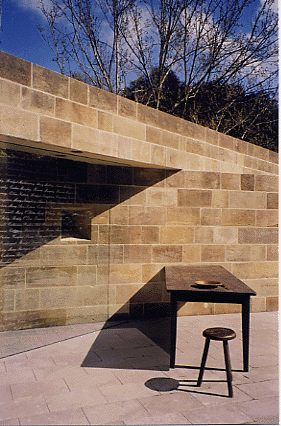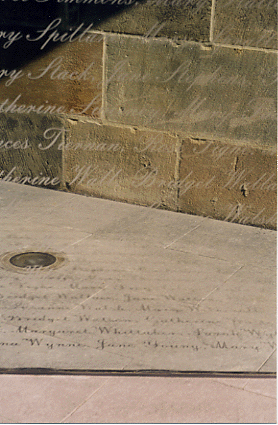|
|
|

Location
Hyde Park Barracks was built in 1817 to house convict men, which it continued to do for nearly 30 years. In 1848 it became an Immigration Depot, housing immigrants including teenaged Irish female orphan refugees from the Great Irish Famine. After 1886 it housed a wide range of Government services until 1981 when it was transformed into a museum. Barracks
The construction of the memorial commenced on 2 September 1998 when Irish President Mary McAleese removed a stone from the wall. The memorial was opened on 28 August 1999 by the Honorable Sir William Deane, Governor-General of Australia. Governor-General's speech
For a description of the memorial from the Irish Times newspaper click here.
 Photos by Mari Metzke
Photos by Mari Metzke
Artists' Interpretation of the Sculpture
"The concept for the sculpture evolved in response to the Barracks site and our investigation into the subject of the Great Famine with its subsequent effect on Irish immigration to Australia. It aims to acknowledge and commemorate the large numbers of often young, single women who arrived in Australia and resided at the Barracks during its time as 'Immigrant Women's Depot and Asylum', 1848-1886. The art work seeks to become an integrated part of the surrounding architectural and landscape design.
"The main focus of the sculpture design is the dislocation of the Barracks southern compound wall. A section of this wall will be dismantled and rebuilt on a rotated axis. In the space of the demolished wall two glass panels bearing sandblasted inscriptions of women's names will be installed, which intersects a bronze cast table projecting outwards in either direction.
"The rotated sandstone wall represents disruption and dislocation. This enables the viewer a degree of visual accessibility to both sides of the artwork while retaining the important physical distance between spaces inside and outside the wall. The dislocation also generates more intimate areas or corners, in the otherwise exceptionally open Barracks courtyard.
"The table, split in two, has on one end a simple bowl with a void in its base that continues through the table. At the other end is a simple institutional table setting with bread and utensils also cast in bronze. This further symbolises the contrast between hunger and comfort which underpinned the role of the Barracks as shelter. The suggestion of continuity in the two ends of the table represents the continuous and evolving relationships between the site and the lives of those who immigrated. The table and the more intimate spaces created within the rotated wall evoke the domestic nature of life and work for the majority of Irish women migrants while their simplicity and sparseness allude to the subject of the Famine."
Hossein and Angela Valamanesh
[from Historic Houses Trust Guidebook Australian Monument to the Great Irish Famine, Sydney, 2001]
Visit our Links page